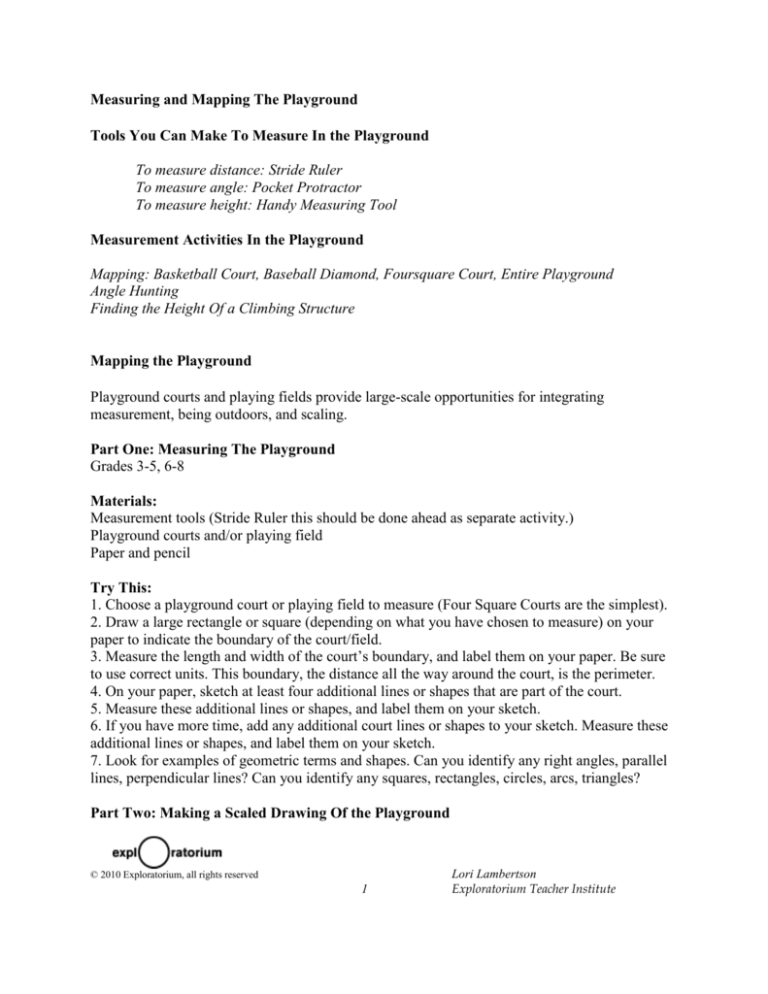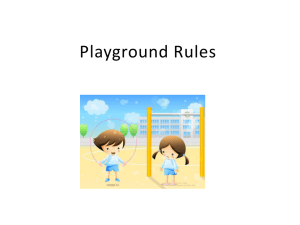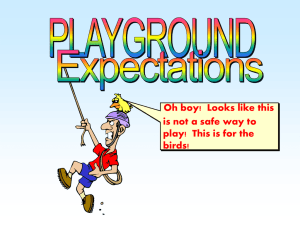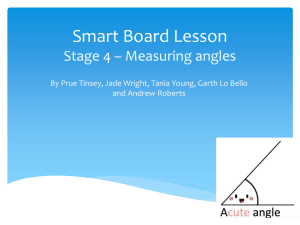
Measuring and Mapping The Playground
Tools You Can Make To Measure In the Playground
To measure distance: Stride Ruler
To measure angle: Pocket Protractor
To measure height: Handy Measuring Tool
Measurement Activities In the Playground
Mapping: Basketball Court, Baseball Diamond, Foursquare Court, Entire Playground
Angle Hunting
Finding the Height Of a Climbing Structure
Mapping the Playground
Playground courts and playing fields provide large-scale opportunities for integrating
measurement, being outdoors, and scaling.
Part One: Measuring The Playground
Grades 3-5, 6-8
Materials:
Measurement tools (Stride Ruler this should be done ahead as separate activity.)
Playground courts and/or playing field
Paper and pencil
Try This:
1. Choose a playground court or playing field to measure (Four Square Courts are the simplest).
2. Draw a large rectangle or square (depending on what you have chosen to measure) on your
paper to indicate the boundary of the court/field.
3. Measure the length and width of the court’s boundary, and label them on your paper. Be sure
to use correct units. This boundary, the distance all the way around the court, is the perimeter.
4. On your paper, sketch at least four additional lines or shapes that are part of the court.
5. Measure these additional lines or shapes, and label them on your sketch.
6. If you have more time, add any additional court lines or shapes to your sketch. Measure these
additional lines or shapes, and label them on your sketch.
7. Look for examples of geometric terms and shapes. Can you identify any right angles, parallel
lines, perpendicular lines? Can you identify any squares, rectangles, circles, arcs, triangles?
Part Two: Making a Scaled Drawing Of the Playground
© 2010 Exploratorium, all rights reserved
1
Lori Lambertson
Exploratorium Teacher Institute
Grades 6-8
Materials:
Sketch from Part One
Pencil
Grid paper
Mathematical compass
Calculator
Ruler
Try This:
1. Choose an appropriate scale for your drawing. (Hint: Count the number of squares across the
length of your grid paper, and compare that number to the longest measurement from your
playground court sketch.) For example, if your paper has 50 squares across its length, and the
length of the basketball court is 23 m long, let one squares equal .5 m. Write the scale factor you
have chosen at the bottom of your grid paper.
2. Use your scale factor to determine the scaled length and width of the outer boundaries of the
playground court you sketched.
23 m x
1 square
=
46 squares
.5 m
3. Use your ruler to carefully draw the scaled perimeter of the playground court. Label these
lengths and widths with their true measurements, not the scaled measurements. For example, the
length of the basketball court on your scaled drawing should be labeled “23 m”.
4. Use your scale factor to determine the scaled lengths and widths of the other lines and shapes
on your sketch.
5. Use your ruler to carefully draw these scaled lines and shapes.
6. Label all your lines and shapes with their true measurements.
Web Resources:
Basketball Court Details:
http://www.basketball-goals.com/basketball%20court%20dimensions.htm#bbcourt
© 2010 Exploratorium, all rights reserved
2
Lori Lambertson
Exploratorium Teacher Institute
Angle Hunting
Grades 3-5, 6- 8
Materials:
Measurement tools (Pocket Protractor – this should be made ahead as a separate activity)
Playground structures
Paper and pencil
Try This:
1. Make sure all your angles are labeled on your Pocket Protractor.
2. On the playground, make a list of structures that have measurable angles. Without using a tool,
can you identify right angles, angles with less than 90°, and angles with more than 90°?
3. To measure a structure’s angles, do the following: squarely face the object you are measuring.
In other words, stand so that you are perpendicular to the plane of the angle, and not off to the
side.
4. Hold the Pocket Protractor at arm’s length, close one eye, and try to fit one of the angles of
your Pocket Protractor into the angle of the structure. You may need to fold or unfold your
Pocket Protractor to find the best fitting angle. If none of the angles of the Pocket Protractor fit
the angle you are measuring, come up with a reasonable estimate.
5. After you have measured an angle, record it on your list.
6. Try measuring the same angle from a different distance, making sure you are still squarely
facing the object you are measuring. What do you notice?
7. Try to find examples of each angle on your Pocket Protractor.
8. If you have time, sketch the structures and label the angles you have measured.
What’s Going On?
You may have noticed that angle measurements don’t change with distance. Angle
measurements are distance invariant.
Extension:
The Playground Patterns Of Cracks activity is another angle hunting opportunity. Because the
Pocket Protractor can be placed on the ground to measure cracks in paved surfaces, the angles
can be measured directly. This is an easier application of the Pocket Protractor.
© 2010 Exploratorium, all rights reserved
3
Lori Lambertson
Exploratorium Teacher Institute
Finding the Height of the Climbing Structure
This activity was developed by Dr. Linda Shore, Director of the Exploratorium Teacher Institute.
Grades 3-5, 6- 8
Materials:
Distance measuring tool (Stride Ruler)
Handy Measuring ratio, rounded to a simple fraction
Climbing Structure, or other tall object
Paper
Pencil
Try This:
1. Choose a Climbing Structure or other tall object to measure.
2. Walk toward or away from the object until its height can just be covered by your extended hand, held
at arm's length. In other words, the tip of your thumb should “line up” with the top of the object, and
the tip of your little finger should “line up” with the bottom of the object.
3. Mark this location on the ground with chalk or a stone or a stick.
4. Pace off distance to object, counting number of steps.
5. Determine the distance to the object by multiplying the number of steps times length of step.
6. Use the following proportion to determine the height of the object:
1 (height of hand)
3 (length of arm)
=
Height of Object
Distance to Object
Recall that the 1/3 ratio expresses the relative height of your extended fingers to the length of your arm.
Please review “Handy Measuring Tool” activity for more information.
Since you know the Distance to Object (from Step 3), the missing information (Height of Object) will be
a measurement three times smaller than the distance to it. Therefore, divide the Distance to Object by 3
to find the Height of Object indirectly.
What’s Going On?
We can use this simple ratio (1/3) to set up a proportion to help us find the height of a distant object
indirectly. This Height/Distance ratio of 1/3 is fixed in this activity, and in order to just cover the height
of an object measured in this way, you must stand three times further away from the object than it is tall.
So What?
Many of the numbers we use in science have never been measured directly – we only know them from
indirect measurements. How far is it to the sun? What is the diameter of Saturn’s rings? These
measurements and many others have never been measured directly. This activity helps students
understand the validity of indirect measurements.
© 2010 Exploratorium, all rights reserved
4
Lori Lambertson
Exploratorium Teacher Institute
Finding the Height of the Climbing Structure
Here is a version suitable for younger students.
Grades K-2, 3-5
Materials:
Climbing Structure, or other tall object
A friend
Pencil
Meter stick, or measuring tape
Try This:
1. Choose a Climbing Structure or other tall object to measure.
2. Ask your friend to stand as close as possible to the object you want to measure.
3. Walk at least 30 steps away from the structure.
4. Turn around, facing your friend (and the structure).
5. Try to imagine another copy of your friend, standing on top of your friend. Is the climbing structure
taller than “two friends tall”? Is the climbing structure taller than “three friends tall”?
6. Here’s a way to check: hold your pencil in your hand, with your elbow straight, extended toward your
friend. Close one eye, and try to hold the pencil so that it looks like it is next to your friend. Move your
hand to the place on the pencil so that a free end of the pencil looks like it’s the same height as your
friend. Now you can use the pencil to see how many “friends tall” the structure is.
7. Use the meter stick or measuring tape to find out the height of your friend.
8. Multiply the height of your friend times the number of “friends tall” climbing structure is. The
product will be the height of the climbing structure.
What’s Going On?
This activity provides a simpler method for finding the height of the tall object indirectly.
© 2010 Exploratorium, all rights reserved
5
Lori Lambertson
Exploratorium Teacher Institute









